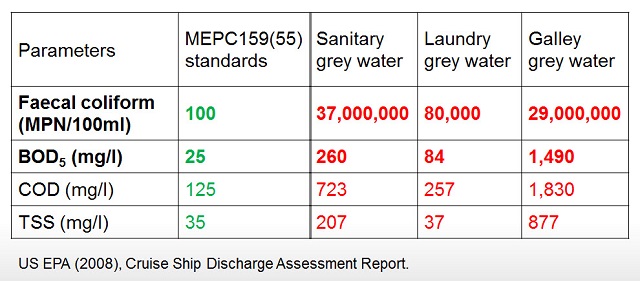Should the Polar Code Regulate Grey Water?
The potential for regulating the discharge of grey water was discussed at IMO when formulating the Polar Code, but, like other times grey water has been discussed, the idea was fairly quickly discarded.
Annex IV of the MARPOL Convention, adopted 40 years ago, sets ambitious standards for ship black water discharges, but grey water is not regulated at all. Therefore, there was little incentive to spend time on it during the Polar Code’s tight timetable for development.
Dr Wei Chen, Future Program Development Manager at Wärtsilä Water Systems, admits that he has not seen any specific risk assessments regarding the discharge of grey water in polar waters. But, he says, the pollution impact of grey water is well known. Grey water from households, communities, and various industries, big or small, has been strictly regulated to the same extent as black water for many decades. If we follow the spirit of MARPOL Annex IV, then grey water should surely be regulated because it has far greater potential for environmental impact than sewage.
Chen cites some of the pollution parameters defined for black water in Annex IV. The levels of fecal coliform, an indication of bacteria; BOD5 and COD, indicators of organic pollutants, and suspended solids (TSS) found in grey water far exceed those found in black water.

“On that basis, grey water should be regulated across the entirety of IMO waters, let alone the polar regions, where we have got high environmental sensitivity,” he says.
As a general guide, galley grey water is similar in pollution content to black water, says Chen. Overall, cruise ship grey water contains far more pollutants than black water. For merchant ships the difference is not as great, but still significant. However, the cruise ship sector has made a significant commitment to grey water treatment. Some advanced technologies produce treated wastewater of far better quality than that discharged from the equivalent facilities on land.
Alaska took the problem into its own hands in 2000 with the introduction of grey water regulations and the monitoring of discharges from passenger ships. Since then, other regional regulations have evolved including regulations covering grey water discharge in the 2013 Vessel General Permit in the U.S.
For Chen, to include grey water in the Polar Code would of course be a benefit for the sensitive polar environments, but nonetheless it is not the ideal approach to the problem. With regional regulations already in place, another separate set of regulations only makes it more difficult for shipowners to comply. Better, he says, to do the full job in MARPOL, including the development of guidelines on how discharge standards should be met.
All the major classification societies have already introduced green notations for ships that treat grey water, and many shipowners are willing. This hasn’t solved the problem, says Chen, as most of the requirements of these notations are vague. “Almost all sewage treatment plant vendors claim they can do black and grey water. That has been going on for many years. However, putting grey water through the final stage of a multi-stage black water treatment system, as is often done, is not really treating grey water. Instead, it is compromising the performance of the type-approved sewage treatment system.”
The final disinfection stage of a black water treatment system does not remove BOD5 or TSS, says Chen. “Therefore, if a system was in compliance treating just black water effluent, it becomes non-compliant once grey water is added.
“If we did regulate grey water in the Polar Code, the new rules would look good on paper but that’s all,” says Chen. “It is better to encompass the big picture even if it is harder to push it through IMO that way. At least then we will have a chance to do it properly and include clear guidelines for implementing systems on ships.” - MarEx
